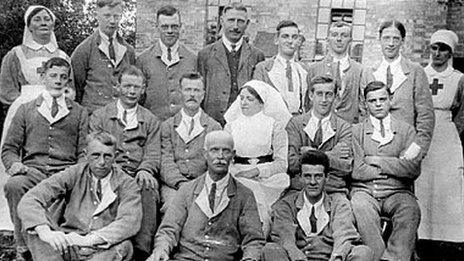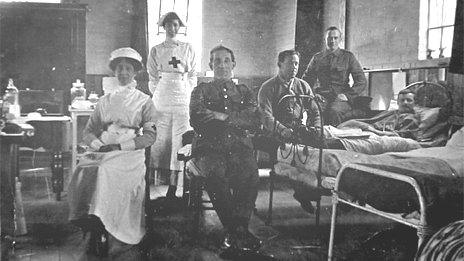WWI photos of soldiers at Shepreth hospital published
- Published

Many photographs were sent in by relatives of nurses who worked at the hospital between 1915 and 1919
When an elderly woman said an uneven village hall floor was ruining her carpet bowls meetings, she had no idea her complaint would reveal the fascinating wartime history of the building.
Carpenters called in to rectify the problem discovered a dusty postcard addressed to a World War I soldier, hidden behind a panel in Shepreth village hall in Cambridgeshire.
The building was used as a military hospital between 1915 and 1919 and it is thought the card, dated 1915, was sent to a soldier while convalescing.
As local historians worked to uncover the story behind it, and identify relatives of the soldier, other people came forward to say they also had postcards and photographs of the hospital from that time.
Many of these have now been published on a new website, external.
Postcard reunited
The postcard that inspired so many to share their memories was addressed to Pte Edward Wolstencroft of the Royal Fusiliers, from a woman named Nellie who was believed to be his elder sister.
It contained several spelling errors and read: "Dear Teddy, Don't think I have forgotten you letter following hopeing you are quite alright love from Nellie xxxx"

The patient in the bed is thought to be Pte Edward Wolstencroft
Pte Wolstencroft returned to France after leaving Shepreth, where he died on 7 July 1916 during the Battle of the Somme.
He is remembered on the war memorial dedicated to missing World War I soldiers at Thiepval in the Picardie region of France.
Amateur family researcher Chris East managed to trace a relative - Paul Wolstencroft, whose father, Thomas, was Pte Wolstencroft's brother - and reunite him with the postcard.
'Fascinating images'
Jordan Smith, 20, one of the founders of the Shepreth Memory Preservation Society has been collating a number of photographs sent in since the Wolstencroft postcard story was publicised.
Many of them are from relatives of nurses who had worked at the hospital during the war, and had taken pictures to add to their family albums.
"Several families very kindly said we could copy the photographs and we felt that as many people as possible should be able to see them," Mr Smith said.
"We hope people find them as fascinating as we do. They show servicemen with nurses in and around the village hall - which hasn't changed that much in the past century."
Not much is known about the convalescing soldiers and others who feature in the photographs, but Mr Smith said he hoped people might recognise some of their relatives.
That would enable him to add more stories to the site in time for the centenary of the outbreak of WWI, which will be commemorated in 2014.
- Published8 April 2012
- Published17 April 2011
- Published23 January 2011
- Published6 January 2011